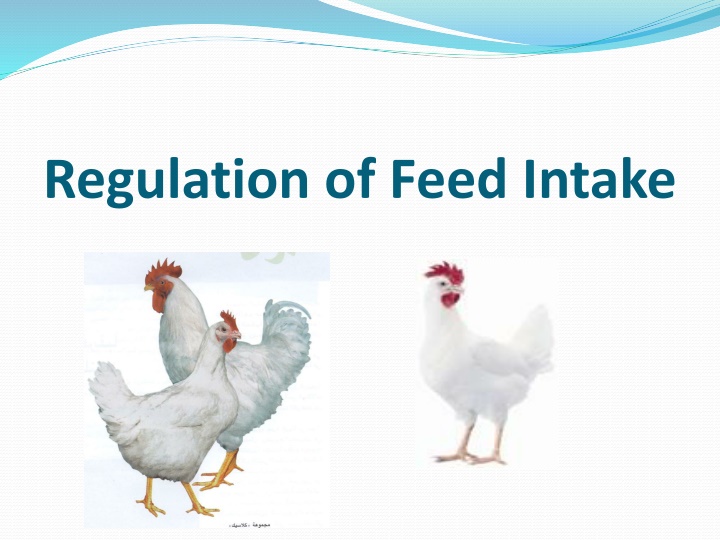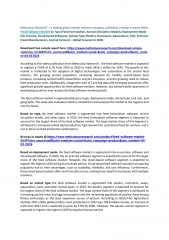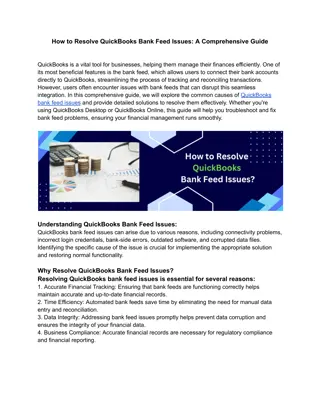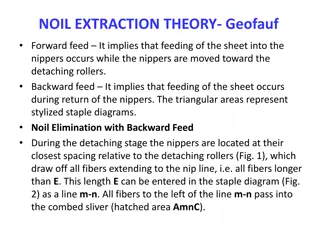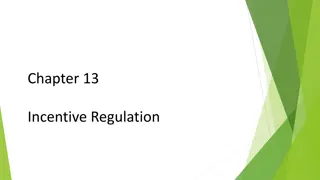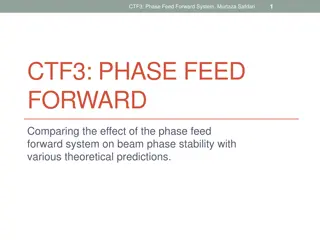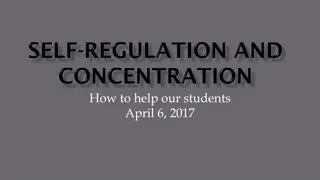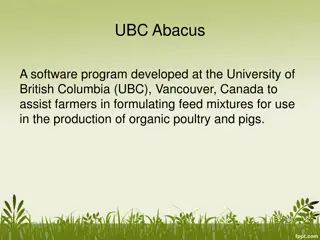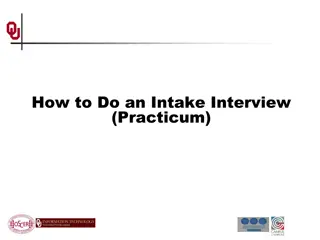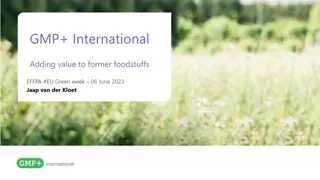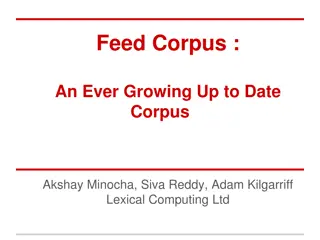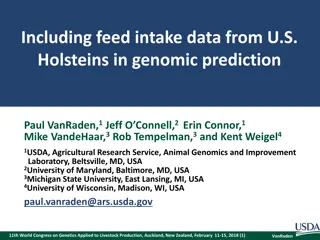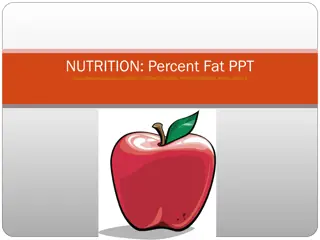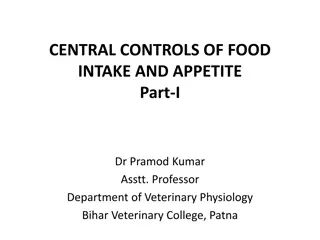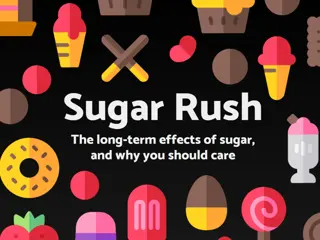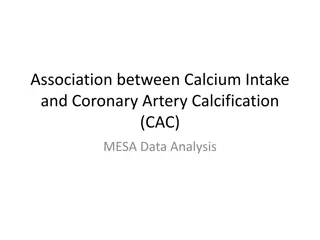Regulation of Feed Intake
Chemicals known as neurotransmitters play a crucial role in regulating feed intake through neuropeptides in the brainstem and hypothalamus. This presentation explores the short-term and long-term systems that control food intake, discussing orexigenic and anorexigenic neuropeptides. Understanding these regulatory mechanisms is essential for optimizing growth and health in animals.
Download Presentation

Please find below an Image/Link to download the presentation.
The content on the website is provided AS IS for your information and personal use only. It may not be sold, licensed, or shared on other websites without obtaining consent from the author.If you encounter any issues during the download, it is possible that the publisher has removed the file from their server.
You are allowed to download the files provided on this website for personal or commercial use, subject to the condition that they are used lawfully. All files are the property of their respective owners.
The content on the website is provided AS IS for your information and personal use only. It may not be sold, licensed, or shared on other websites without obtaining consent from the author.
E N D
Presentation Transcript
Summarized & Presented By Ahmed M. Al-Zahrani PhD student Animal Science Department Physiological Digestibility in Monogastric Advisor Prof. Tarek Shafey
Contents Introduction. Why this presentation? A System for Regulating Feed Intake Short-Term System Long-Term System An Integrated Regulator System Neuropeptidergic Regulation of Food Intake Orexigenic Neuropeptides Anorexigenic Neuropeptides Conclusions
Neurotransmitters : Chemicals transfer signals between a neuron and anothercell Effect depend on the anatomical site (eg, norepinephrine increases feeding when infused into the paraventricular nucleus but decreases feeding when injected into the lateral hypothalamus) BW is constant/homeostatic even with ad libitum (the conceptof short-and long-term control of food) FI regulation in the brain involves neuropeptides (orexigenic or anorexigenic)
Within the CNS, the brainsteam & the hypothalamus playcritical roles in the regulation of FI & EB. The CNS mammals. of chickens regulates FI similar to regulation of FI and EB in birds and mammals involves similar: regulatory mechanisms, neural pathways and neuroanatomical sites
To nuropeptides controling: Feed Regulation & EB Not only say Because of genetics !! strengthen our understanding of Important for growth and health to understand factors involved in feeding behavior
A System for Regulating Feed Intake (Short & long-term system)
Regulations of FI include a central system to control FI This CS comprises specific neural sites and circuits in the brainstem and hypothalamic regions. That receives input from two major peripheral systems
The Satiety signals which influence satiety center of hypothalamus are: Absorption of nutrients from the digestive tract Presenceof nutrients in the circulating blood Control of FI in short term (meal to meal): Involves hormonal and neural signals Originate in the gut, pancreas and liver
Peptide gastrointestinal tract: satiety signals produced by Ghrelin: stimulate feeding behavior CCK & Bombesin: h it Peptide Satietysignals: Brainstem hypothalamus (Why?) Toactivate neural pathways That modulate FI in the short-term
Activated in the hypothalamus & maintained constant BW even if it is altered by Starvation Or forced feeding The net result is a system that: Cumulatively regulates meal-to-meal FI Long-term maintenanceof energy (fat) storage Achieve EH and stability in BW
Hypothalamus :- Contains: Multiple peptidergic neuronal pathways Involved: Regulation of FI & EH These pathways are: Anabolic: Mediates a net increase in EI and storage Catabolic: Results in a net decrease in EI and storage Changes in the circulating level of leptin & insulin: Signal the hypothalamus to effect LT changes in EB By activating or inhibiting specific anabolic & catabolic efferent pathways
Numbers of signaling molecules function in peripheral and central sites to activate specific neural circuits that effect changes in FI as well as in EM. But these Signals need receptors
Anorexigenic/catabolic Orexigenic/anabolic Leptin1 NeuropeptideY (NPY)1 -Melanocyte stimulating hormone ( - MSH)1 Agouti-related peptide (AGRP)1 Corticotrophin releasing hormone (CRH, CRF) (MCH) Melanin concentrating hormone Thyroid releasing hormone (TRH) Orexins/hypocretins3 Cholecystokinin (CCK) Peptide YY (PYY) Bombesin/gastrin releasing peptide (GRP) Pancreatic polypeptide (PP) Ghrelin2 Galanin Somatostatin (SIRF) -Endorphin
Anorexigenic/catabolic Orexigenic/anabolic Gastrin Dynorphin Calcitoningene-related peptide (CGRP) (GHRH) Growth hormone releasing hormone Urotensin I/urocortin Norepinephrine Neurotensin Glucagon/glucagon-like peptide 1 (GLP-1) Serotonin Dopamine Epinephrine
An Integrated Regulatory System
Thecoordinateregulationof FI and EB involves: Environmental cues (feed availability, photoperiod, and temperature) physiological metabolite levels, and energy stores). Internal signals (hormone levels, The brain plays a pivotal role in this process of integration.
Neuropeptidergic Regulation of Food Intake
(1) Neuropeptide Y (NPY): Neuropeptide Y (NPY) stimulates FI chicken & mammals. Peptide YY was much more potent than NPY in eliciting food consumption
(2) Opioids: ICV of - and -opioid receptor agonist stimulated FI in chicks Opioids, act on the and/or -opioid receptor have an important role in feeding behavior in the CNR of broiler 1-opioid has relation to NPY-induced feeding
(3) Arg-Phe-NH2 (RFamide): Two RFamides have been revealed as orexigenic factors in neonatal chicks (PrRP & GnIH). a- (PrRP): Acts as prolactin release inhibitory peptide & orexigenic factor in mammals chicks - reverse in Central administration FI in rats. ICV injection FI in chicks.
b- (GnIH): The ICV injection of GnIH, GnIH-RP-1 and GnIH- RP-2 significantly stimulated FI in chicks. ICV human QRFP showed no significanteffect on FI
(1) Glucagon Superfamily It regulate appetite in the chick brain as an anorexigenic factor Central administration of GLP-1 strongly h FI of neonatal chicks (GRF) is known to stimulate feeding behavior in rats
(2) Gastrin/Cholecystokinin (CCK) Family a- CCK: FI in chickens: When injected directly into CNS Alsowith Peripheral injections. Stimulate gastric emptying pancreatic enzymes toaid in the digestion of feed Satiety signal to the brainstem & depressing appetiteand, hence, the drive to feed. If injected intravenously abdominal discomfort FI (indirect) & the release of
b- Gastrin ICV injection of chicken gastrin inhibits FI and FP in chicks. injections decapeptide of chicken gastrin h FI Subcutaneous of the C-terminal
(3)Corticotropin-Releasing Factor(CRF) Family CRF decreased FI in chicks. Thereare two CRF receptorsubtypes: (CRF1R) & (CRF2R), in fish, amphibians, chickens and mammals. The CRF1R antagonist did not compete with CRF in suppression of FI in mice on the contrary, the CRF2R antagonist completely reversed the anorexigenic action of CRF in rats, suggesting that CRF suppresses FI via the CRF2R.
(4) a-Melanocyte Stimulating Hormone (MSH) a-MSH, h FI of mammals. ICV of a-MSH h FI in 3h fasted chicks in a dose- dependent. a-MSH strongly h NPY-induced feeding The POMC produce bioactive -MSH which play an important role in regulating FI in chickens.
(5) Bombesin In turkeys, food & water intake in both the peripheral and CNS (due to discomfort ratherthan aanorexigeniceffect) ICV injection in neonatal chicks h FI Central suppressed by coinjection of bombesin. administered NPY-induced FI was
(6) Ghrelin In rats, central and peripheral ghrelin FI mainly through the activation of NPY neurons. ICV injection of ghrelin h FI in chickens.
(7) Arginine-Vasotocin (AVT) AVT is a stress-related peptide in the brain of birds ICV injection of AVT: h feeding behavior rectal temperature plasma corticosteroneconcentrations
(8) Glutathione ICV injection of GSH dose-dependently FI in chicks. The in FI induced bya hypnotic effectof GSH. (9) Carnosine Present in high concentration in the muscle & brain of mammalian & avian species ICV h FI in adose-dependent
Short-term Involves hormonal and neural signals originate in the gut, pancreas and liver. Long-term maintain EH & stability in BW (by activating or inhibiting specific anabolic and catabolic efferent pathways)
Some anorexigenic effect may indirect (caused by abdominal discomfort) Neuropeptides function in avian & mammals will be either: Anorexigenic in one but orexigenic in theother Anorexigenic in both ororexigenic in both
Thank You For Attendance
